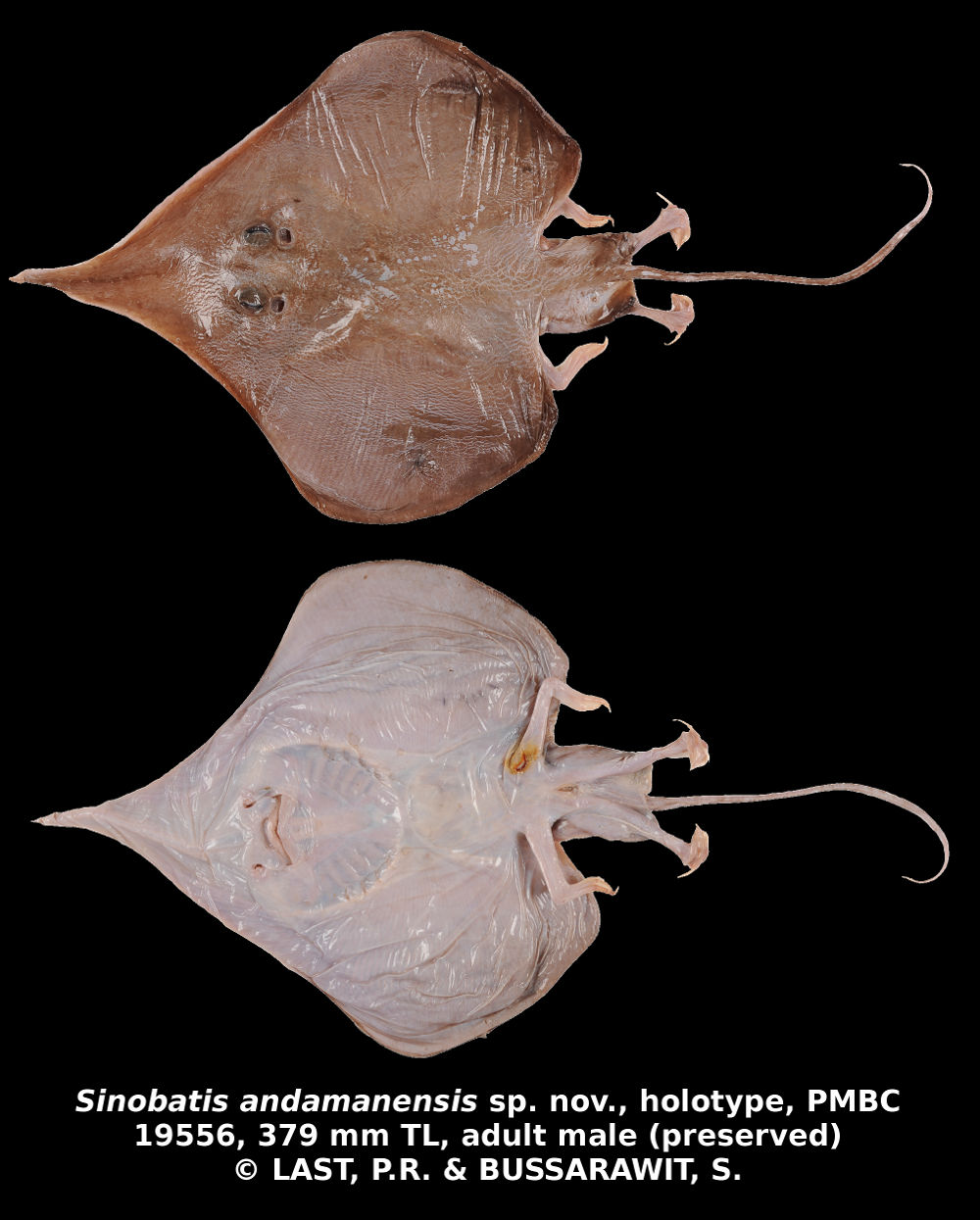Sinobatis andamanensis
Last & Bussarawit, 2016
Classification: Elasmobranchii Rajiformes Anacanthobatidae
Reference of the original description
A new legskate, Sinobatis andamanensis (Rajiformes: Anacanthobatidae), from the Andaman Sea (northeastern Indian Ocean). Zootaxa, 4168(1), 161–170
A new legskate, Sinobatis andamanensis (Rajiformes: Anacanthobatidae), from the Andaman Sea (northeastern Indian Ocean). Zootaxa, 4168(1), 161–170
Types
Sinobatis andamanensis
Holotype: PMBC: 27938 (formerly 19478–5); Paratype: CSIRO: H 8041-01 (19478–2); PMBC: 27939 (formerly 19478–1); PMBC: 27940 (19478–3); PMBC: 27941 (19478– 4); PMBC: 27942 (19478–6);
Sinobatis andamanensis
Holotype: PMBC: 27938 (formerly 19478–5); Paratype: CSIRO: H 8041-01 (19478–2); PMBC: 27939 (formerly 19478–1); PMBC: 27940 (19478–3); PMBC: 27941 (19478– 4); PMBC: 27942 (19478–6);
Description :
Citation: Sinobatis andamanensis Last & Bussarawit, 2016: In: Database of modern sharks, rays and chimaeras, www.shark-references.com, World Wide Web electronic publication, Version 12/2025
Please send your images of "Sinobatis andamanensis" to info@shark-references.com

Sinobatis andamanensis sp. nov, holotype, PMBC 19556, 379 mm TL, adult male (preserved) © Last, P.R. & BUSSARAWIT, S.

Sinobatis andamanensis sp. nov, holotype, PMBC 19556, 379 mm TL, adult male (preserved) © Last, P.R. & BUSSARAWIT, S.
Common names
 Andaman Legskate
Andaman Legskate
 Andaman Legskate
Andaman Legskate
Short Description
Original diagnosis after LAST & BUSSARAWIT, 2016 [24422]: Small Sinobatis with the following combination of characters: relatively narrow disc (width at anterior orbit 3.7–4.9 times mouth width); very long snout with slightly bulbous tip and a short, filament; moderately elongate tail (postcloacal length 127–157% of disc length); medium-sized eyes, orbit diameter 6.6–10.3 in horizontal snout and 8.2–12.8 in head lengths respectively; distal portion of tail not expanded laterally; moderate-sized pelvic fins, anterior lobe 14.3–16.1% TL; anterior pelvic-fin lobe narrow-based, width 2.7–5.0 in distance between pelvic-fin origins; caudal fin long-based and very low; 23–29 tooth rows in each jaw; teeth of adult males with short subconical cusps; pectoral-fin radials 66–72; abdominal vertebral centra 26, total centra to caudal fin origin ~125–131; dorsal and ventral surfaces both bluish when fresh, skin on dorsal surface darker and opaque, almost transparent ventrally.
Original diagnosis after LAST & BUSSARAWIT, 2016 [24422]: Small Sinobatis with the following combination of characters: relatively narrow disc (width at anterior orbit 3.7–4.9 times mouth width); very long snout with slightly bulbous tip and a short, filament; moderately elongate tail (postcloacal length 127–157% of disc length); medium-sized eyes, orbit diameter 6.6–10.3 in horizontal snout and 8.2–12.8 in head lengths respectively; distal portion of tail not expanded laterally; moderate-sized pelvic fins, anterior lobe 14.3–16.1% TL; anterior pelvic-fin lobe narrow-based, width 2.7–5.0 in distance between pelvic-fin origins; caudal fin long-based and very low; 23–29 tooth rows in each jaw; teeth of adult males with short subconical cusps; pectoral-fin radials 66–72; abdominal vertebral centra 26, total centra to caudal fin origin ~125–131; dorsal and ventral surfaces both bluish when fresh, skin on dorsal surface darker and opaque, almost transparent ventrally.
Distribution
Continental slope in the Andaman Sea off Phuket (western Thailand) [24422] Source: www.gbif.org
Continental slope in the Andaman Sea off Phuket (western Thailand) [24422] Source: www.gbif.org
Dentition
Teeth of adult males with slightly elevated subcircular crowns; single cusp on each crown of holotype, short, broadly triangular; cusps typically shorter than diameter of crown, longest near symphysis, very short near corners of mouth; lingually directed near symphysis, directed almost laterally from about eight rows either side of symphysis; females and juveniles with oval crowns, each with a short posterior cusp. [24422]
Teeth of adult males with slightly elevated subcircular crowns; single cusp on each crown of holotype, short, broadly triangular; cusps typically shorter than diameter of crown, longest near symphysis, very short near corners of mouth; lingually directed near symphysis, directed almost laterally from about eight rows either side of symphysis; females and juveniles with oval crowns, each with a short posterior cusp. [24422]
Remarks
shark-references Species-ID=14697;
shark-references Species-ID=14697;

















